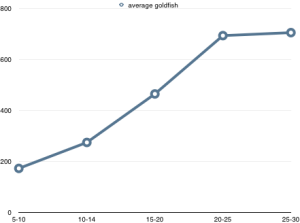Respiration rate, that's where it's at. And everyone knows the coolest thing to measure anything against is heat. Logically, this means it must be time for Mr. Wong's 7th period Biology Honors class in sublime Bellarmine College Prep to do a lab linking respiration rate to temperature. We drew lots, and one lucky fellow was picked to be thrown into a large vat of ice water for the sake of science. Then, after gradually decreasing the water temperature even further several times, we turned around and dumped him into some warm water just for variety.
Nothing of the sort of buffoonery described in the last two sentences came even close to occurring. Doing those sort of things to a human being is basically the antithesis of every of moral rule I've ever followed. Doing similar things to a goldfish, however, is perfectly acceptable. Granted, of course, that the ice water doesn't fall beneath 5 degrees Celsius and that the warm water doesn't transcend an uncomfortable 30 degrees Celsius.
The overall purpose of the experiment was simple-- seek out a relationship between heat and the respiration rate of a goldfish. Likewise, the methods used mirrored this guilelessness. We simply warmed or cooled the water the fish were in to be within a certain temperature bracket and counted the number of times their operculum opened and closed in a period of five minutes.
I hypothesized that the respiration rate would raise with temperature because in lower temperatures, the fish's systems would slow down overall to increase conservation of energy.
On the whole, the combined efforts of my team plus two other teams gave data on a total of six fish, though for three of them the highest-temperature data point was missing.
My data is presented in the following graphs, clearly demonstrating one thing: though at any single heat level respiration rates are all over the scale, the respiration rate of any particular fish clearly increases as temperature of the water goes up.
Nothing of the sort of buffoonery described in the last two sentences came even close to occurring. Doing those sort of things to a human being is basically the antithesis of every of moral rule I've ever followed. Doing similar things to a goldfish, however, is perfectly acceptable. Granted, of course, that the ice water doesn't fall beneath 5 degrees Celsius and that the warm water doesn't transcend an uncomfortable 30 degrees Celsius.
The overall purpose of the experiment was simple-- seek out a relationship between heat and the respiration rate of a goldfish. Likewise, the methods used mirrored this guilelessness. We simply warmed or cooled the water the fish were in to be within a certain temperature bracket and counted the number of times their operculum opened and closed in a period of five minutes.
I hypothesized that the respiration rate would raise with temperature because in lower temperatures, the fish's systems would slow down overall to increase conservation of energy.
On the whole, the combined efforts of my team plus two other teams gave data on a total of six fish, though for three of them the highest-temperature data point was missing.
My data is presented in the following graphs, clearly demonstrating one thing: though at any single heat level respiration rates are all over the scale, the respiration rate of any particular fish clearly increases as temperature of the water goes up.
|
Temperature in Degrees Celsius
|
5-10
|
10-14
|
15-20
|
21-25
|
26-30
|
|
Respiration Rate per Five Minutes for Fish 1
|
40
|
190
|
490
|
674
|
|
|
Respiration Rate per Five Minutes for Fish 2
|
188
|
292
|
430
|
610
|
|
|
Respiration Rate per Five Minutes for Fish 3
|
150
|
372
|
546
|
642
|
|
|
Respiration Rate per Five Minutes for Fish 4
|
218
|
241
|
263
|
516
|
641
|
|
Respiration Rate per Five Minutes for Fish 5
|
213
|
282
|
542
|
724
|
728
|
|
Respiration Rate per Five Minutes for Fish 6
|
220
|
275
|
517
|
628
|
743
|
This becomes even more clear once the data points are averaged out into one line.
|
Temperature in Degrees Celsius
|
5-10
|
10-14
|
15-20
|
20-25
|
25-30
|
|
Average Goldfish Respiration Rate per Five Minutes
|
171.5
|
273.3
|
463.3
|
692.3
|
704
|
In analysis and conclusion, the data fully and clearly supports my hypothesis that the respiration rate would rise with heat. Though the respiration rates of the six subject fish may be scattered greatly within any single temperature bracket, (and indeed, this could be expected, given the disparity in many factors within the ranks of the fish) the overall trend in respiration rate is indisputably upwards in relation to temperature. In fact, in all the data there is not one instance of respiration rate lowering against rising temperature. As the need of the goldfish to conserve energy diminishes in significance, the lowering of respiration rate in accordance to this need is likewise diminished, leading to an overall increase in respiration rate with temperature.
And so ended another smashing lab in Mr. Wong's seventh-period Biology Honors class at wonderful Bellarmine College Prep..
.JPG)

.png)

